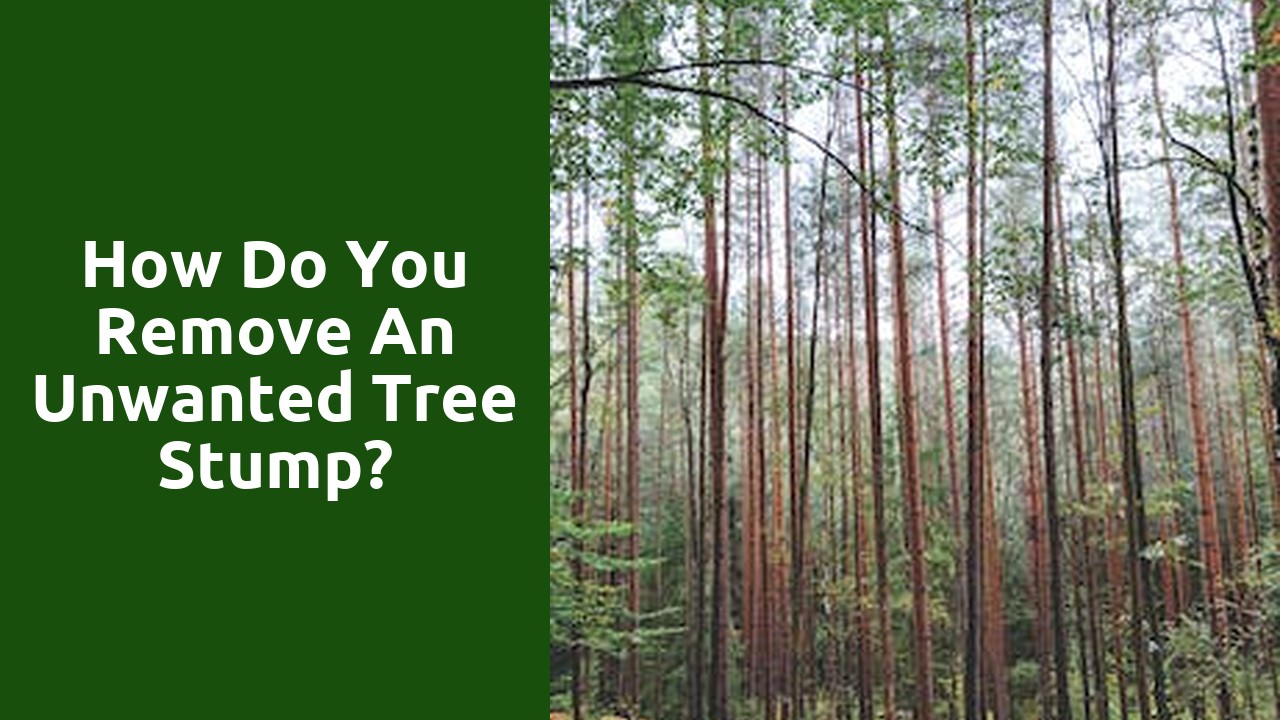How do you remove an unwanted tree stump?

Why is the tree stump unwanted?
One may ask, why is the tree stump unwanted? Well, the answers can be both practical and aesthetic. Firstly, from a practical standpoint, tree stumps can pose a safety hazard. As they remain firmly rooted in the ground, they can become tripping hazards for pedestrians, especially in areas with high foot traffic. Furthermore, tree stumps can impede landscaping and hinder the growth and development of other plants in the vicinity.
From an aesthetic perspective, tree stumps can be seen as unsightly and disrupt the overall appearance of a garden or outdoor space. They serve as a constant reminder of the once-living tree that stood there, creating an eyesore that is difficult to ignore. Additionally, over time, tree stumps may start to decay, attracting pests like termites and ants, which can further impact the surrounding environment. As a result, many homeowners and garden enthusiasts choose to remove tree stumps to maintain a clean and visually appealing outdoor area.
Determining the size and condition of the stump
To effectively remove a tree stump, it is crucial to accurately determine its size and condition. Firstly, measuring the dimensions of the stump will help determine the appropriate tools and techniques needed for its removal. By assessing the width and height of the stump, you can effectively plan the steps required for extraction. Additionally, observing the condition of the stump is vital in understanding its structural integrity. Check for any signs of decay, rot, or infestation, as these factors can impact the difficulty level and safety considerations involved in the removal process. A thorough evaluation of the stump's size and condition will provide valuable insights and assist in executing a successful stump removal operation.
Assessing the surrounding area for potential obstacles
Before moving forward, it is crucial to assess the surrounding area for any potential obstacles that may impede progress or pose a risk. This careful evaluation allows for the identification of any physical barriers, uneven terrain, or other hazards that could hinder the intended activities.
One aspect to consider is the presence of natural obstacles, such as large rocks, fallen trees, or bodies of water. These elements can impact movement and require additional planning or precautionary measures. Furthermore, man-made structures like fences, buildings, or construction sites must also be taken into account, as they might restrict access or obstruct pathways. By thoroughly examining the environment, potential obstacles can be identified proactively to ensure a smooth and safe progression.
Choosing the right method for stump removal
One of the crucial steps in tree removal is getting rid of the stump left behind. The process of stump removal not only ensures a clean and aesthetically pleasing landscape but also prevents potential hazards and promotes healthy growth of your plants. When it comes to choosing the right method for stump removal, there are several factors to consider.
First and foremost, take into account the size of the stump. For smaller stumps, manual removal methods such as digging or pulling might be sufficient. These methods require physical effort but can be cost-effective. On the other hand, larger stumps may require more powerful techniques like stump grinding or stump removal by professionals. These options are quicker and more efficient, but they usually come at a higher cost. Additionally, consider the location of the stump and its proximity to structures, utilities, or other plants. Carefully assess the potential impact of different removal methods to minimize any damage or disruption to your surroundings.
Manual methods of removing a tree stump
There are several manual methods available for removing a tree stump. One commonly used technique involves digging around the stump to expose its roots. Once the roots are exposed, a sturdy axe or a saw can be used to cut through them. This process requires some physical strength and persistence, as it may take time to cut through all the roots. However, with the right tools and determination, this method can be effective in removing the stump entirely.
Another manual method for stump removal is the use of a mattock or a grub hoe. This tool is specifically designed for digging and chopping out stubborn roots. The mattock's sharp end can be used to sever the roots, while the wider end can be utilized for prying and loosening the stump. With careful and strategic use, the mattock can help in gradually removing the stump from the ground. Although this method may take some effort and patience, it offers a practical option for those who prefer manual techniques over using heavy machinery.
Using chemical stump removers
Stump removal can be a tedious and time-consuming process, but using chemical stump removers can provide a convenient solution. These products are specifically designed to accelerate the decomposition of tree stumps, making it easier to remove them from your yard. Chemical stump removers work by breaking down the lignin, which is the structural component of the wood, resulting in a weakened and rotted stump over time.
One of the advantages of using chemical stump removers is that they are relatively simple to use. Most products come in powder or granular form, which you can easily apply to the stump. After following the instructions provided, the chemical will gradually penetrate the wood, helping to hasten the decomposition process. However, it is important to note that the effectiveness of chemical stump removers can vary depending on factors such as stump size, wood type, and environmental conditions. Patience is key when using these products, as it may take several weeks or even months for the stump to become sufficiently decomposed for removal.
Related Links
How do you remove a stump cheaply and effectively?What is the fastest way to get rid of a tree stump?